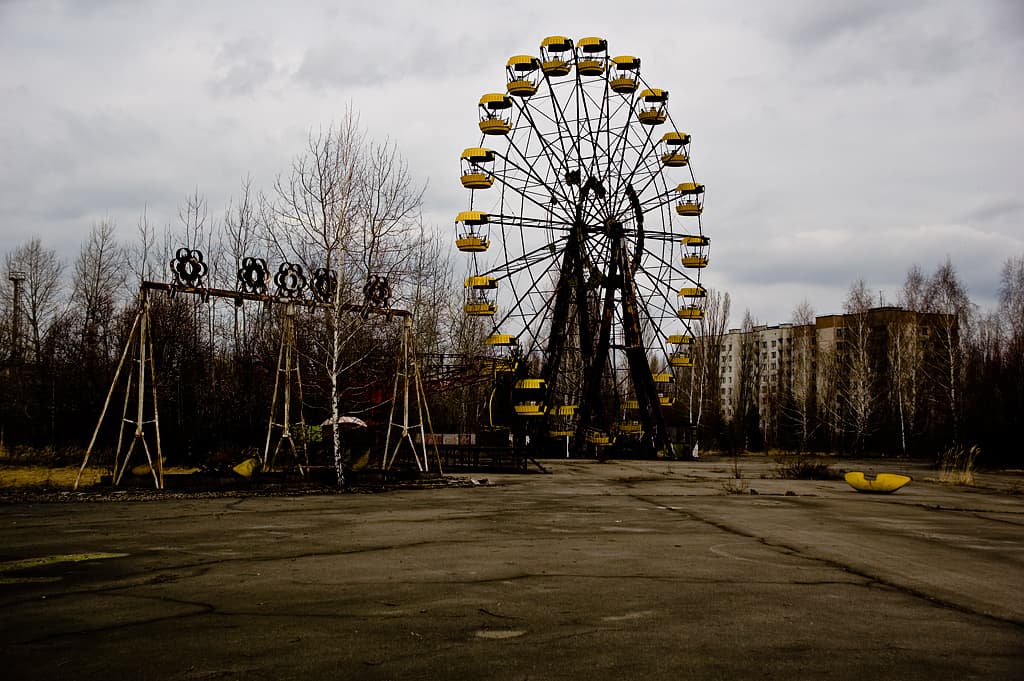
One does not simply walk into Chernobyl. Over and above the fences and government safety measures meant to keep people from wandering through the shell of this once-thriving energy supply town, there is, of course, the radiation. The former city of Pripyat, Ukraine is probably the most famous ghost town in the world, completely evacuated following the 1986 meltdown of the nuclear reactor which had been the community’s major source of employment. In 2010, the government of Ukraine reopened the site to tourists – and if you’re willing to abide by their strict but justified rules, it can be a safe and fascinating look into a modern-day Pompeii.
Pripyat was evacuated in just two days, following the nuclear disaster – and some say even this wasn’t quick enough. The speed of their withdrawal has left the city with a mood some call eerie, others melancholy, while still others see a beautiful tableau illustrating life at the height of Soviet power. Travellers commonly report seeing discarded children’s toys, but just as affecting are the less dramatic details: a broken down wall provides a glimpse into an average family home, coffee table still pulled up close to an analog-dial television, where the family likely first heard news of the evacuation order.
Preserved in Pripyat is a slice of life that an increasing number of people are excited to see for themselves. The haunting visuals are made all the more otherworldly by the creep of Nature; one of the site’s most iconic features, a small amusement park with a famously melancholy Ferris wheel, has been slowly overtaken by the wildlife and greenery. In fact, one surprising feature of the Pripyat area is its recolonization by animals. Though many had thought the area uninhabitable by all but the hardiest of insects, a wide array of mammals have returned and now thrive. Outside species introduced to the area quickly sicken, but populations evolving on the outskirts of the area slowly developed immunities that let them return to reclaim their former habitat.
Today, entering the so-called “exclusion zone” is a carefully regulated activity. The easiest way to obtain a day pass from the government is to go through a registered tour operator – though true adventure seekers are technically able to obtain personal passes, as well. This is not recommended, however, as the dangers of the Chernobyl area go much further than a higher than usual daily dose of radiation; wildlife, natural hazards, and even criminals exploiting the area’s isolation, are all threats mentioned by Ukraine.
If you go the sensible route, contract a professional tour operator to lead you and your group through the ghost town and its surrounding wilderness, you’ll be treated to a comprehensive and far-reaching tour. Though the expectation might be that an official tour would skirt the best stuff for reasons of safety or general government boringness, this is still Eastern Europe; if you’ll sign the waiver, they’ll let you do it. As a result, tours often take travellers right into city areas, through major attractions, and even on a tour of the infamous Reactor 4 itself!
Don’t worry too much about the radiation exposure – one little known fact is that the Chernobyl reactors have to this day dozens of regular staff running them and even extracting (a significantly lowered amount of) power. The site will take several more years to fully decommission, and employees work in strict shifts to avoid overly large doses of radiation. Though a trip through Chernobyl will definitely increase your average radiation intake for the month, a single visit is considered a negligible risk.


